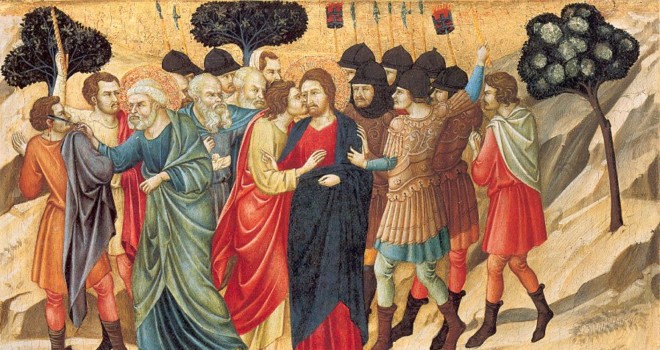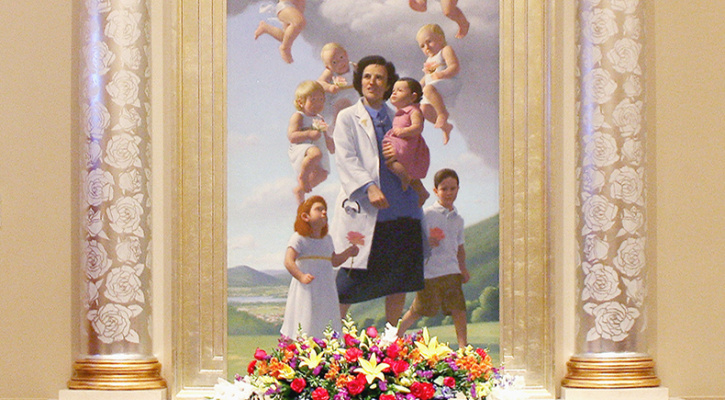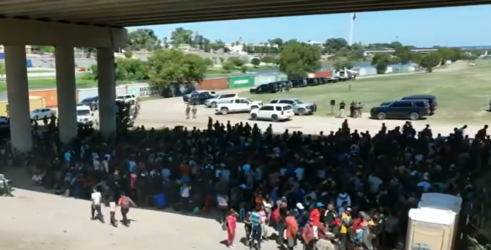After the kiss of betrayal, Judas slunk back into the group that had come to capture Jesus. His work was done. Now all he had to do was to watch anxiously in the hope that Jesus’ captors would fulfill their part of the bargain and not allow Him to slip away as He had so often in the past.
Jesus had no such intention. Instead of waiting for His enemies to act, He spoke to them: “Whom do you seek?” It was probably the officers of the Temple guard who replied, “Jesus of Nazareth.” Our Lord identified Himself: “I am he.” In spite of the sign Judas had given them, Christ’s enemies seemed confused. They suspected that this man who had come boldly forward to meet them could not be the one they had come to arrest.
St. John tells us that when Jesus spoke the words, “I am he,” His enemies “drew back and fell to the ground.” While a natural explanation of this fall is possible, there is no doubt that St. John considered it a miraculous manifestation of our Lord’s power. It is not likely that the whole group fell; probably it was only those in the front rank, the officers of the Temple guard who had addressed Jesus.
Our Lord permitted something of His divine power and majesty to shine forth in His words and looks, and His enemies recoiled quickly, falling over those immediately behind them. This was not the first time that Jesus had overawed His enemies by the majesty of His presence (see John 7:44; 10:39). Now He will let them have their way because it is the will of His Father, but not before showing them that He is acting freely. He will fulfill the prophecy of Isaiah: “He shall be led as a sheep to the slaughter, and shall be dumb as a lamb before his shearer” (53:7). But He will do it not from weakness but by choice.
The Situation & the Sword
The enemies of Christ quickly appraised the situation. Christ was giving Himself up without resistance and dismissing His disciples. Since there was to be no conflict there was no danger, so some of the band, eager now to show their zeal and courage, stepped forward quickly and seized Jesus. Judas kept enough of his love and respect for the Master to prevent him from laying hands on Him. He let others do it. The Apostles were stunned at this turn of events. Never before had they seen Jesus subjected to such an indignity. On other occasions when His enemies had sought to take Him, He had walked quietly away. Now they saw Him held firmly in their grasp.

This article is from a chapter in The Last Hours of Jesus.
Yet, even in this emergency, the Apostles turned to our Lord for directions: “Lord, shall we strike with the sword?” Two of them were armed with swords. Earlier in the evening, misunderstanding our Lord’s recommendation: “Let him who has no sword sell his tunic and buy one,” they had replied to Jesus, “Behold, here are two swords” (Luke 22:36, 38). They may have thought that this was the emergency to which our Lord referred. Their valor was greater than their prudence. Armed with two swords, the few of them were ready, at Christ’s word, to throw themselves onto a much larger armed group backed up by a detachment of Roman soldiers.
At this point, the action was rapid, as Christ had no time to reply to their question. The impetuous Peter was beside himself at the sight of his beloved Master in the hands of His enemies. He did not wait for Jesus to reply. He stepped forward quickly and swung his sword lustily at the head of Malchus, the servant of the high priest, who was evidently one of those holding our Lord. Either Peter’s aim was poor or Malchus dodged quickly, as the blow only grazed his head and cut off his right ear.
Even as Peter struck, our Lord spoke, perhaps in answer to the question of the Apostles whether they should strike with the sword. “Bear with them thus far,” He said. The meaning of these words is doubtful. Perhaps Jesus meant simply, “Let be, no more violence,” or else, “Let things take their course; permit them to arrest me.” In the scuffle, Malchus must have loosed his hold on Christ, who took advantage of this freedom to touch Malchus’ wounded ear and heal it. Peter might have fared very poorly later that evening in the courtyard of the high priest if it had not been for Christ’s miracle of healing.
Jesus was still in command of the situation. Turning now to Peter, He told him: “Put back thy sword into its place; for all those who take the sword will perish by the sword” (Matt. 26:52). Jesus would have no part in a violent defense. The reason He gave in this verse is proverbial in form, probably an expression current among His contemporaries.
Violence engenders violence, the spilling of blood brings on the spilling of more blood. Recourse to the sword must have the sanction of the civil power, or it will bring upon one the punishment of the sword. Furthermore, Jesus had no need of their help. “Dost thou suppose that I cannot entreat my Father, and he will even now furnish me with more than twelve legions of angels?” (26:53). A legion consisted of six thousand men. Instead of twelve weak Apostles to defend Him, He could call upon the Father for twelve times six thousand angels to aid Him.
After addressing Peter, Jesus turned to the motley group that had come out to arrest Him. Although He spoke to all, He directed His remarks particularly to the leaders, who bore the responsibility for what was taking place — the chief priests, the captains of the Temple, and the ancients. “As against a robber have you come out,” Jesus said to them, “with swords and clubs. When I was daily with you in the temple, you did not stretch forth your hands against me” (Luke 22:52–53).
The Arrest
Jesus did not make objection to the arrest but to the manner and time and place. They had proceeded against Him as if He were a brigand, the leader of a band of armed robbers, an outlaw who must be captured by a combination of stealth and armed force. If there was a question of doctrinal differences, they knew very well that they would find Him teaching in the Temple area. They could have arrested Him in broad daylight and brought Him before the Sanhedrin. Jesus knew why they had not — and they knew too. They understood the tone of accusation in Jesus’ words. They feared the people because of the malice in their motives and the patent injustice of the whole proceeding.
Yet there is a deeper significance in what was taking place. These men were evil and the executors of an evil design. Nevertheless their actions were a fulfillment of a prophecy, for Christ went on to say: “It is so that the Scriptures may be fulfilled” (Mark 14:49). What they were doing was being used by God and fitted into the great plan of our redemption.
For the moment, however, Christ’s enemies appeared to have everything their own way. “But this is your hour, and the power of darkness,” Jesus said (Luke 22:53). They had tried many times to lay hands on Him and could not because His hour had not yet come. Now they were free to act. Satan, the prince of darkness, had entered into Judas, the instigator of the plot that was now coming to a successful conclusion. The hour of Christ’s enemies and the hour of the power of darkness were the same, because these men were acting as the allies and tools of Satan.
The Disciples Fled
After addressing His enemies, Jesus fell silent. The Evangelists do not tell us whether there was a discussion among the Apostles as to what they should do; nor was there much time for talk, in any case. The Gospels simply tell us what the Apostles did: “Then all his disciples left him and fled” (Matt. 26:56).
Their flight was a shameful act. They deserted Jesus at the first approach of real danger and left Him in the hands of His enemies. Nevertheless, we should not find it difficult to temper the severity of our condemnation. Jesus had in effect dismissed them when He said, “If therefore you seek me, let these go their way.” He had rejected their appeal to the sword, and on the other hand He showed no sign of flight. They had to decide quickly what to do, while the attention of the band was still centered on Jesus, and they decided to take the path of personal safety. When they saw Jesus held firmly by His captors and making no effort to overcome them or to escape, they slunk back into the shadows and fled into the darkness of the olive trees. Here was fulfilled the prophecy that Christ had recalled early in the evening: “I will smite the shepherd, and the sheep of the flock will be scattered” (Matt. 26:31). St. John in his flight must have looked back over his shoulder, for he alone adds the pathetic detail: they “seized Jesus and bound him” (18:12).
Once Jesus was securely bound and surrounded by armed guards, the group formed in marching order for the return to the city. St. John tells us that “they brought him to Annas first, for he was the father-in-law of Caiaphas, who was the high priest that year” (18:13). Ancient tradition places the palace of Annas — probably the same as that of Caiaphas — on the west hill of the city, only about two hundred feet from the Upper Room, where Jesus had eaten the Passover a few hours earlier.
The Young Man Who Fled
It was the dead of night, and the city and its environs were silent in sleep. The only signs of life were the watchmen on the walls and at the Fountain Gate. There was one exception, however, and St. Mark alone among the Evangelists records it. After stating that the Apostles deserted Jesus and fled, St. Mark adds: “A certain young man was following him, having a linen cloth wrapped about his naked body, and they seized him. But leaving the linen cloth behind, he fled away from them naked” (14:51–52).
A study of the original text of St. Mark adds a little to our knowledge of this incident. The one who followed Jesus was quite young — in fact, still in his teens. He did not follow at a distance, but mingled with the group. This would indicate that he was not inspired by curiosity but by a real interest in the case and was therefore a disciple of Jesus. That he slept in a special linen garment is evidence that he was well off, as the ordinary peasant or worker had no special night clothes.
He could not have been with the group very long before someone noticed that he was an intruder and called attention to him. They quickly seized him, but he slipped out of his linen garment, leaving it in their hands, and fled naked.
Who was this young man? From early times, efforts have been made to identify him, but they amount to little more than conjecture. Many think it was St. Mark himself, since he alone thought the incident worth recounting.
The Gospel narrative does not tell us at what point in the march from Gethsemane to the palace of Annas this event occurred. It is usually placed immediately after the departure. It is possible that the young man was the son of the owner of the villa of Gethsemane and was awakened from sleep by the noise of the arrest. The possibility cannot be ruled out that he lived in a house along the route taken by the cortege and was awakened as it passed. There is an early tradition that the mother of St. Mark owned the house in which the Last Supper took place. If tradition is correct in the localization of the Cenacle and of the palace of Annas, the group with their prisoner passed near the Cenacle. The house of the mother of Mark was one of the first meeting places of the earliest Christians. It was there St. Peter went after his miraculous release from prison (Acts 12:12).
The evidence is not conclusive, but what little there is indicates that the young man was St. Mark. If it was St. Mark, we can well imagine that the event remained vividly impressed on his memory the rest of his life. If the other Evangelists knew of it, they passed it over as of no particular significance. To St. Mark it was like a seal with which he signed his Gospel, just as St. John refers to himself in his Gospel as the “disciple whom Jesus loved.”








